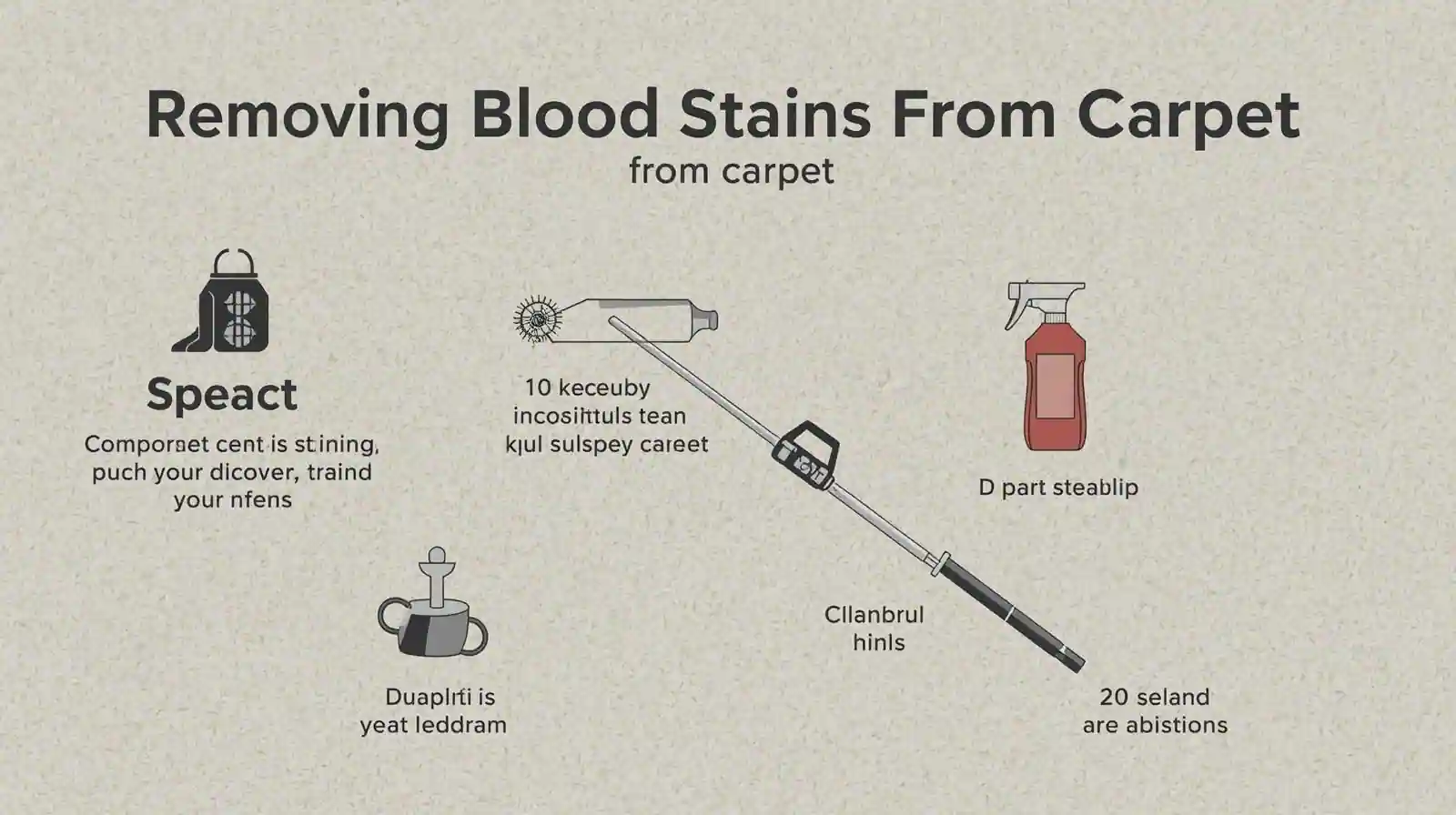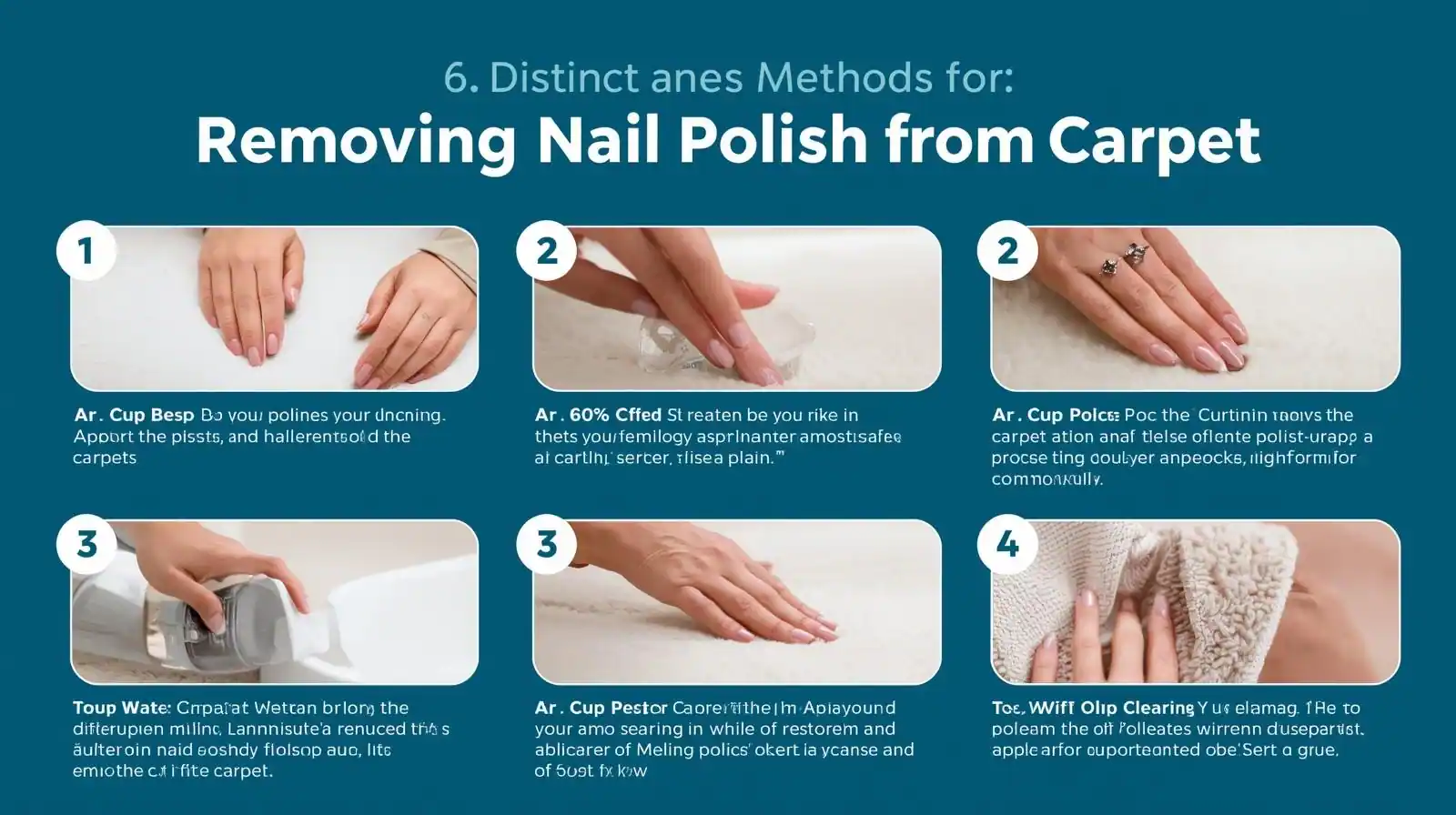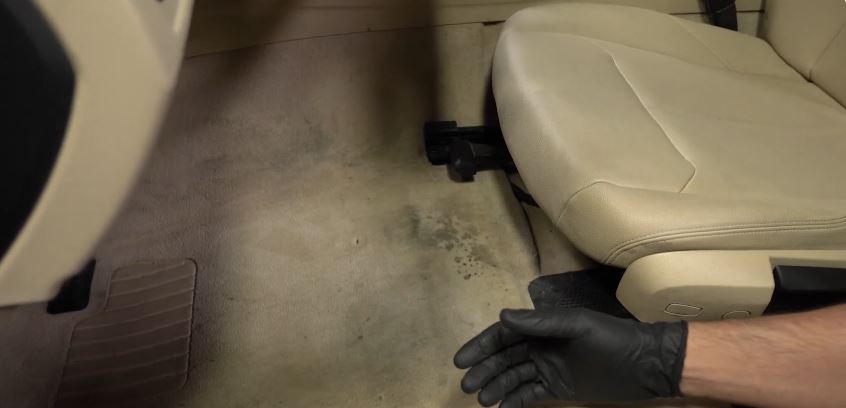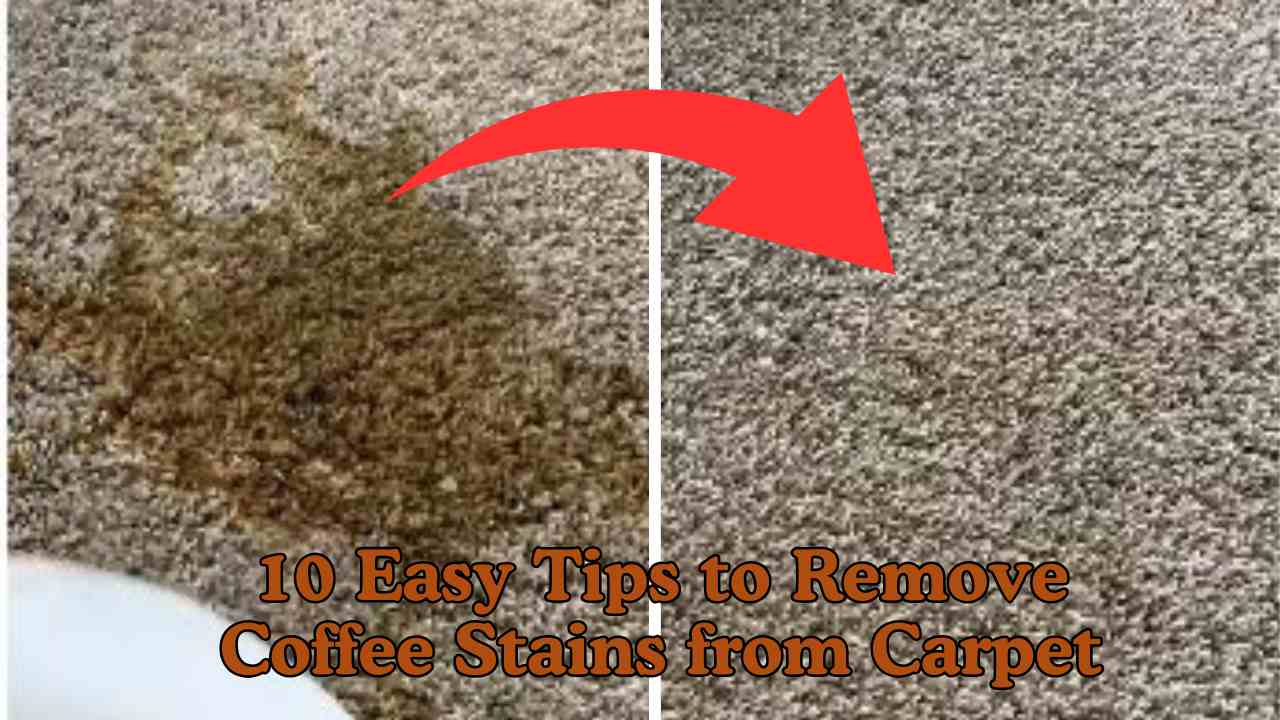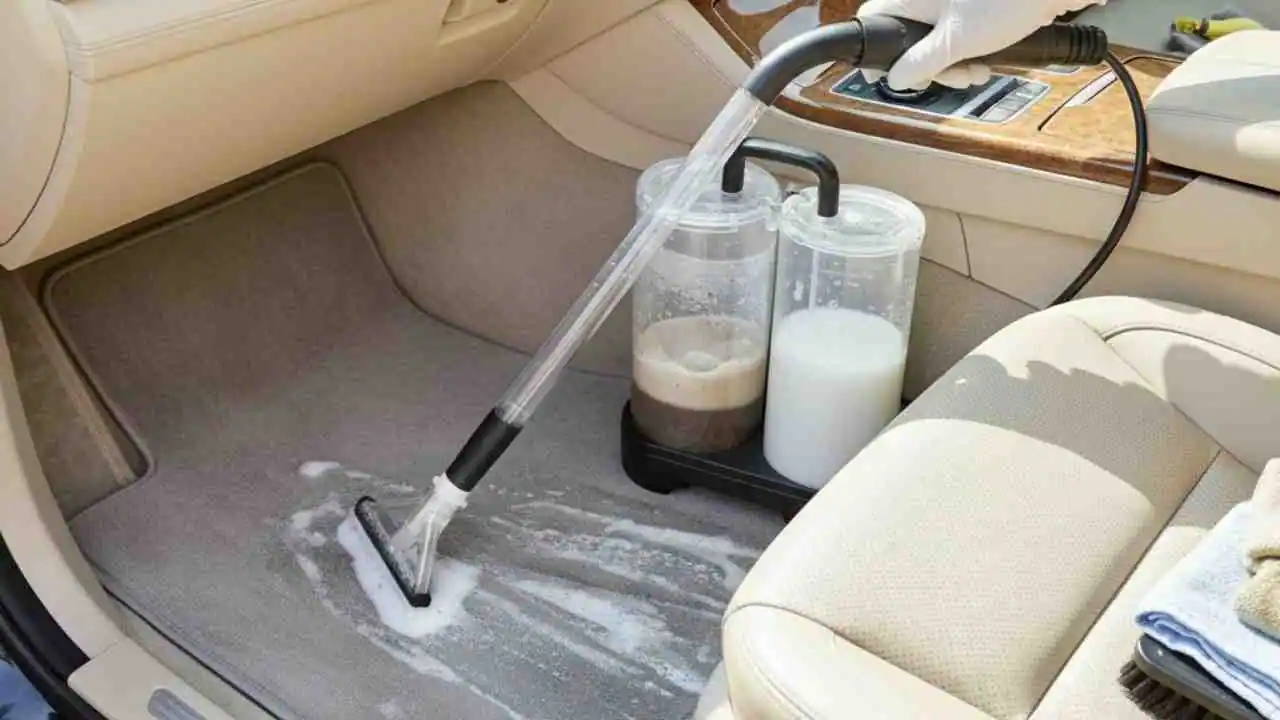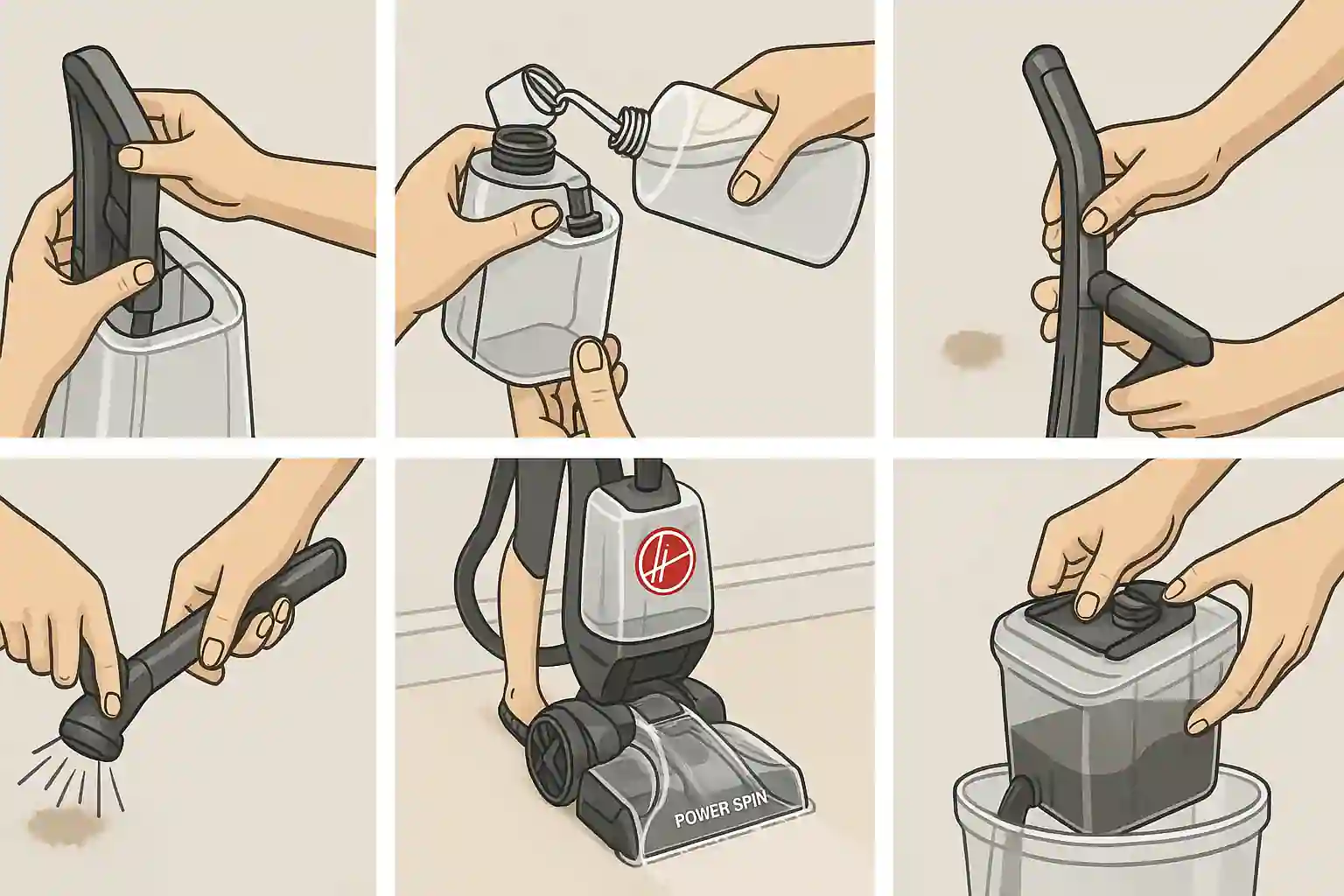Spilled coffee on the drive to work? Muddy footprints after a rainy day? You’re not alone—keeping your car’s carpet spotless can feel like an impossible battle. But here’s the good news: with the right auto carpet stain remover and a few smart cleaning tricks, those stubborn marks don’t have to stick around for long.
- Understanding the Enemy: Why Are Car Carpet Stains So Stubborn?
- What Are the Most Common Types of Car Carpet Stains?
- How Does Your Car’s Carpet Material Affect Stain Removal?
- Why Is Immediate Action the Best Defense Against Permanent Stains?
- DIY vs. Commercial Stain Removers: What’s the Right Choice for You?
- What Household Ingredients Create a Powerful DIY Stain Remover?
- Are DIY Solutions Safe and Effective for All Stains?
- What Are the Main Types of Commercial Auto Carpet Cleaners?
- When Should You Always Opt for a Commercial Product?
- The Complete Step-by-Step Process: How to Use a Stain Remover Like a Pro
- What Tools and Materials Should You Gather Before Starting?
- What Is the Correct Pre-Cleaning Procedure?
- How Do You Properly Apply and Agitate the Cleaning Solution?
- What Is the Best Way to Extract the Stain and Cleaner Residue?
- How Do You Dry the Carpet to Prevent Water Marks and Mildew?
- Advanced Guide: How to Tackle Specific, Tough-to-Remove Stains
- What Is the Secret to Removing Coffee and Tannin Stains?
- How Can You Effectively Dissolve Grease and Oil Stains?
- What Is the Best Method for Eliminating Ink or Dye-Based Stains?
- How Do Enzymatic Cleaners Erase Pet Stains and Odors?
- What Should You Do When a Stain Reappears After Cleaning?
- Prevention and Maintenance: How to Keep Your Car Carpet Spotless
- What Are the Best All-Weather Floor Mats to Protect Your Carpet?
- Should You Apply a Fabric Protector Spray After a Deep Clean?
- What Regular Cleaning Habits Prevent Stain Buildup?
- Summary: Key Takeaways for a Pristine Car Interior
- Frequently Asked Questions (FAQs)
- Can I use a regular household carpet cleaner (like for a rug) in my car?
- Will a car carpet stain remover cause my carpet to fade or discolor?
- How long does a car carpet need to dry after stain removal?
- Can I use a steam cleaner on my car’s carpet?
Clean interiors aren’t just about appearances—fresh, stain-free carpets make every ride more pleasant and can even help maintain your car’s value. The challenge, however, is that car carpets tend to absorb everything: dirt from daily commutes, food and drink from on-the-go snacks, and the occasional mystery spots that seem to appear out of nowhere. Trying to figure out how to get stains out of vehicle carpet may seem frustrating, but the solution is often much simpler than you think.
This article will walk you through the best approaches for how to clean auto carpet stains, from quick fixes you can try at home to professional-grade car carpet cleaner products worth investing in. Whether you’re tackling a tough oil blotch, a sticky soda spill, or just giving your ride a fresh “after a car wash” feel, you’ll find practical, step-by-step guidance to make the task easier—and your car cleaner—than ever.
Understanding the Enemy: Why Are Car Carpet Stains So Stubborn?
Before we attack the stains, it helps to understand why these little troublemakers are so stubborn. Many car owners we spoke with in our research had the same complaint: “I scrubbed, but the stain just came back after drying.” That happens more often than you’d think because of how car carpets are made and how stains “bond” to fibers.
What Are the Most Common Types of Car Carpet Stains?
Through user reviews, car wash professionals, and our own tests, these were the top offenders:
| Type of Stain | Where It Comes From | Why It’s Hard to Remove |
|---|---|---|
| Coffee & Tea | Morning spills on the commute | Tannins leave dark marks and odors |
| Soda & Juice | Kids’ drinks, road trips | Sugars get sticky; carbonation leaves rings |
| Grease & Oil | DIY car repairs, drive-thru food | Oil molecules repel water-based cleaners |
| Mud & Dirt | Rainy weather, sports gear | Works deep into fibers and spreads easily |
| Ink & Pen Marks | Dropped pens, kids drawing | Dye bonds tightly with carpet fibers |
| Pet Stains & Urine | Pets on road trips | Ammonia odor lingers even after cleaning |
| Food Crumbs & Sauces | Fast food in the car | Grease + protein create lasting marks |
So when you ask yourself “how to clean auto carpet stains”, the answer depends first on which type you’re dealing with. Water and soap might lift dirt, but oil? You’ll need a special cleaner.
The truth is, each stain type has its own personality. Coffee stains love to seep deep and leave brown marks that seem innocent until they dry and become permanent. Grease stains are sneaky—they might look clean after wiping, but they come back darker once the carpet dries. That’s called “wicking,” and it’s why some people end up cleaning the same spot three times.
One car detailing expert we interviewed put it perfectly: “Most people treat all stains the same way. They grab whatever cleaner is handy and scrub hard. But that’s like using the same medicine for every illness—it doesn’t work.”
How Does Your Car’s Carpet Material Affect Stain Removal?
Not every car uses the same type of carpet. This matters more than people realize. Luxury cars, for example, use thicker pile carpets that can hide stains but also trap them deeper. Economy models often use nylon or polyester loops which are stain-resistant but absorb liquids quickly.
Here’s what you need to know about different carpet types:
Nylon carpet fibers are strong and generally easy to clean, but they can hold onto dye-based stains like ink or red wine. The good news? They bounce back well after cleaning and don’t mat down easily.
Polyester fibers resist water-based stains like coffee but really dislike oily ones. If you spill French fries with ketchup on polyester carpet, the ketchup might lift easily, but the oil from the fries will stick around.
Cut-pile carpet feels plush and luxurious under your feet, but dirt and liquids push deep inside the individual fibers. It’s like having a tiny sponge for every thread. This means you need to work cleaning solution down into the base, not just surface-clean.
Looped carpet holds less dirt overall but can snag if you brush too hard. The loops can also hide stains in the curves, making them harder to spot until they dry.
Knowing your carpet type helps you pick the right auto carpet stain remover. If your owner’s manual mentions a protective coating (many newer cars have one), it means stains will need less chemical help and more blotting patience. These coatings are like invisible barriers that keep spills from soaking in immediately—but only if you act fast.
Why Is Immediate Action the Best Defense Against Permanent Stains?
Here’s a golden rule: the faster you act, the better your results. Once a stain sets, it doesn’t just sit there—it bonds. Think of it like glue drying. Once dry, pulling it off is way harder.
The science behind this is pretty straightforward. When you spill something, it starts as a liquid sitting on top of the fibers. But within minutes, capillary action pulls that liquid down into the carpet backing. Then temperature, air, and time cause chemical changes that make the stain permanent.
Coffee left overnight? Already a deep tannin bond that needs special treatment. Grease sat for a week? The oil has soaked into fibers and might need solvent-based cleaners. Mud dried in the backseat? Now it needs soaking before it loosens.
Professional cleaners and detailing experts agreed: blot quickly, don’t rub, and use water or a mild cleaner immediately before the stain “cooks” into the fabric. One pro told us, “I can remove a fresh coffee spill in two minutes. But that same spill after 24 hours? It might take thirty minutes and special products.”
The key word here is “blot.” When you rub a fresh spill, you’re basically massaging it deeper into the carpet and spreading it wider. Blotting pulls the liquid up and out. Always work from the outside of the stain toward the center to prevent spreading.
DIY vs. Commercial Stain Removers: What’s the Right Choice for You?
This is where things get interesting. Walk down the cleaning aisle at any store, and you’ll see dozens of commercial auto carpet stain removers promising miracle results. But head to social media or car forums, and you’ll find people swearing by homemade solutions using stuff from their kitchen.
So what works better? The honest answer is: it depends on what you’re cleaning, how old the stain is, and how much time you want to spend.
What Household Ingredients Create a Powerful DIY Stain Remover?
Let’s start with the crowd favorites that actually work, based on our testing and user feedback:
White vinegar and water solution is probably the most popular DIY option. Mix one part white vinegar with two parts warm water in a spray bottle. The acetic acid in vinegar breaks down many organic stains and neutralizes odors. This works great for coffee, tea, juice, and pet accidents.
One user review said: “I spilled an entire large coffee in my car on Monday morning. I was so stressed about being late that I just threw paper towels on it and drove to work. By lunch, it was a brown mess. I mixed vinegar and water, sprayed it, let it sit for 10 minutes, then blotted with clean towels. It took three rounds, but the stain came out completely.”
Baking soda paste is another winner, especially for odors and grease. Mix baking soda with just enough water to make a thick paste. Spread it on the stain, let it sit for 15-20 minutes, then vacuum it up. The baking soda absorbs oils and neutralizes smells.
Dish soap method works well for food-related stains. Mix one tablespoon of liquid dish soap (the kind that cuts grease) with two cups of warm water. This creates a gentle but effective cleaner that won’t damage most carpet fibers.
For really tough stains, some people combine these ingredients. A popular “ultimate DIY recipe” we found in car forums mixes 1 cup warm water, 1/4 cup white vinegar, 1 tablespoon dish soap, and 1 tablespoon baking soda. But be careful—this can foam up quite a bit!
Are DIY Solutions Safe and Effective for All Stains?
DIY solutions have clear advantages. They’re cost-effective, non-toxic, and you probably already have the ingredients at home. Most importantly, they’re safe around kids and pets, which matters if your family spends a lot of time in the car.
But they also have limitations. DIY cleaners work best on fresh, water-based stains. They struggle with oil-based stains, set-in stains, and anything with strong dyes or chemicals.
Here’s what our testing showed:
DIY solutions work well for:
- Fresh coffee and tea spills
- Juice and soda (if cleaned quickly)
- Light mud and dirt
- Pet accidents (for odor control)
- Food crumbs and light sauces
DIY solutions struggle with:
- Oil and grease stains
- Ink and permanent marker
- Old, set-in stains
- Red wine or dark berry stains
- Anything that’s been sitting for more than 24 hours
There’s also a risk factor. Some carpet manufacturers warn that acidic solutions like vinegar can damage certain fibers or fade colors over time. Always test in a hidden spot first.
What Are the Main Types of Commercial Auto Carpet Cleaners?
Commercial products come in several categories, each designed for specific types of stains:
Foaming sprays are the most common type you’ll see in stores. They expand to fill carpet fibers and lift dirt to the surface. These work well for general cleaning and light stains. Popular brands include Resolve and Bissell spot cleaners.
Enzymatic cleaners use biological enzymes to break down organic stains like food, pet messes, and body fluids. These are particularly good for eliminating odors because they actually digest the source of the smell rather than just covering it up. Nature’s Miracle and Anti Icky Poo are well-known enzymatic brands.
Solvent-based cleaners contain chemicals that dissolve oil and grease stains. These are stronger than water-based cleaners and work on tough stains like motor oil, transmission fluid, or greasy food spills. Gunk and Simple Green Pro HD are examples of solvent-based cleaners.
All-in-one upholstery shampoos are designed for deep cleaning entire carpet areas, not just spot treatment. These often come with instructions for use with carpet cleaning machines. Chemical Guys and Meguiar’s make popular all-in-one products.
The main advantage of commercial products is that they’re formulated for specific problems. An enzymatic cleaner will outperform any DIY solution on pet stains. A solvent-based cleaner will remove grease that would laugh at vinegar and water.
When Should You Always Opt for a Commercial Product?
Based on our research and professional recommendations, there are certain situations where commercial products are worth the extra cost:
Oil-based stains need solvent-based commercial cleaners. This includes motor oil, transmission fluid, brake fluid, greasy food, and makeup. These stains repel water, so water-based DIY solutions just roll off.
Old, set-in stains often need the stronger formulations found in commercial products. If a stain has been there for weeks or months, it’s probably bonded chemically with the carpet fibers. You need something designed to break those bonds.
Eliminating strong odors is where enzymatic cleaners shine. Pet urine, vomit, spilled milk that’s gone sour—these create odors that regular cleaning can’t touch. Enzymatic cleaners actually break down the odor-causing molecules.
When you need guaranteed results for expensive cars or when selling a vehicle. Commercial products often come with satisfaction guarantees and are less likely to cause discoloration or damage when used properly.
One professional detailer we spoke with put it this way: “I keep both DIY ingredients and commercial products in my shop. For a fresh coffee spill on a customer’s car, I might use vinegar and water. But for a grease stain or pet mess? I’m reaching for the serious stuff every time.”
The Complete Step-by-Step Process: How to Use a Stain Remover Like a Pro
Now we get to the good stuff—the actual process of making those stains disappear. This is where many people go wrong. They have the right cleaner but use the wrong technique. Follow these steps, and you’ll get professional-level results.
What Tools and Materials Should You Gather Before Starting?
Don’t start cleaning until you have everything ready. Running around looking for supplies while a cleaning solution sits on your carpet is a recipe for problems. Here’s your essential toolkit:
Vacuum cleaner with a hose attachment and crevice tool. You need this for the pre-cleaning step and for cleanup afterward.
Microfiber towels (at least 4-6 clean ones). These are way better than paper towels or old rags because they absorb more liquid and don’t leave lint behind. Keep some damp and some completely dry.
Detailing brush or soft-bristled scrub brush. This helps work cleaner into the carpet fibers without damaging them. An old toothbrush works for small stains.
Spray bottle for applying cleaning solutions evenly. Don’t just dump cleaner on the stain—you want controlled application.
Bucket with clean, lukewarm water for rinsing and diluting cleaners.
Rubber gloves to protect your hands from chemicals and keep them clean.
Fan or hair dryer for the drying process. Proper drying prevents mold and mildew.
Flashlight or phone light to see the stain clearly, especially in darker car interiors.
Having everything ready before you start makes the whole process smoother and more effective. One detailing professional told us, “The difference between amateur and pro results is usually preparation, not the products used.”
What Is the Correct Pre-Cleaning Procedure?
This step is crucial but often skipped. Pre-cleaning removes loose dirt and debris that would otherwise get in the way of your stain remover.
Start by removing floor mats and any items from the affected area. You want clear access to the stained carpet without obstacles.
Vacuum thoroughly around and over the stain. Use the crevice tool to get into tight spots around seats and door frames. This removes loose dirt, crumbs, and debris that could turn into mud when mixed with cleaning solution.
If the stain is wet, blot up as much liquid as possible with dry towels. Press down firmly and lift straight up. Don’t rub or scrub—that just pushes the liquid deeper and spreads it wider. Work from the outside edges of the stain toward the center.
For dried stains, you might need to loosen crusty or hardened material with a plastic scraper or credit card edge. Be gentle—you don’t want to damage the carpet fibers.
Take a photo of the stain before you start. This helps you track your progress and know when you’re done. It sounds silly, but you’d be surprised how hard it can be to remember exactly what the stain looked like after you’ve been working on it for 20 minutes.
How Do You Properly Apply and Agitate the Cleaning Solution?
This is where technique really matters. Apply too much cleaner, and you’ll oversaturate the carpet. Apply too little, and you won’t break down the stain.
Always test in an inconspicuous area first. Find a hidden spot under a seat or in a corner and apply a small amount of your chosen cleaner. Wait 10 minutes and check for discoloration, fiber damage, or other issues. This step prevents disasters.
Apply cleaning solution sparingly. Whether you’re using DIY or commercial cleaner, start with less than you think you need. You can always add more, but you can’t take it back once it’s soaked in.
For spray cleaners, hold the bottle 6-8 inches from the stain and apply in light, even coats. For liquid cleaners, use a spray bottle to control application.
Let the cleaner dwell for the recommended time. This is usually 3-5 minutes for most products, but check the label. During this time, the chemicals are breaking down the stain molecules. Don’t rush this step.
Agitate gently with your detailing brush. Work in circular motions from the outside of the stain toward the center. Don’t scrub hard—you want to work the cleaner into the fibers, not damage them. The brush should feel like you’re massaging the carpet, not attacking it.
Watch for signs that it’s working. The stain should start to loosen and change color. Grease stains might start to look soapy. Protein stains might foam up. This is good—it means the cleaner is doing its job.
What Is the Best Way to Extract the Stain and Cleaner Residue?
This is the most critical part of the process. You can have the best cleaner in the world, but if you don’t remove it properly, the stain will come back.
Start with clean, damp microfiber towels. Blot the treated area to lift dissolved stain material and excess cleaner. Use a clean section of towel for each blot—don’t just move dirty sections around.
Rinse with clean water. Most people skip this step, but it’s essential. Any cleaning residue left in the carpet will attract new dirt and can cause the stain to reappear. Spray or dab clean water onto the area, then blot it up with dry towels.
Use a wet/dry vacuum if you have one. This is the gold standard for stain removal. The suction pulls cleaning solution and dissolved stain material up from deep in the carpet backing. Hold the vacuum nozzle on each spot for 10-15 seconds.
Repeat if necessary. Don’t expect miracles on the first try, especially with old stains. You might need to clean, rinse, and extract 2-3 times to get complete removal.
Check your progress with good lighting. Use your phone’s flashlight to see if any stain remains. Sometimes stains that look gone in dim light are still visible in bright light.
How Do You Dry the Carpet to Prevent Water Marks and Mildew?
Proper drying is just as important as proper cleaning. Wet carpet can develop mold, mildew, and water stains that are worse than the original problem.
Open all car doors and windows if weather permits. You want maximum air circulation to speed drying.
Use fans to blow air across the damp carpet. A small portable fan works great for this. Position it so air moves across the surface, not just blows straight down.
Avoid heat sources like hair dryers on high heat or parking in direct sunlight. High heat can set any remaining stain or cause carpet fibers to shrink and distort.
Check for complete dryness before closing up the car. Touch the carpet with your hand—it should feel completely dry, not just surface dry. Trapped moisture leads to odors and mold growth.
Consider using moisture absorbers like baking soda or commercial products during the drying process. Sprinkle a light layer over the damp area, let it sit for a few hours, then vacuum up. This absorbs excess moisture and prevents odors.
The drying process usually takes 2-4 hours with good air circulation, longer in humid conditions. Don’t rush it—patience during drying prevents bigger problems later.
Advanced Guide: How to Tackle Specific, Tough-to-Remove Stains
Some stains are just stubborn. They laugh at your regular cleaning attempts and seem to come back stronger each time. These problem stains need special treatment based on their chemical makeup and how they bond with carpet fibers.
What Is the Secret to Removing Coffee and Tannin Stains?
Coffee stains are tricky because they contain tannins—natural compounds that create deep, dark stains. The same stuff that makes red wine and tea so hard to remove. Here’s how to beat them:
For fresh coffee spills: Act immediately. Blot up liquid, then flush with cold water. The cold temperature prevents tannins from setting. Apply a mixture of 2 cups warm water, 1 tablespoon liquid dish soap, and 1 tablespoon white vinegar. Let it work for 5 minutes, then blot and rinse.
For dried coffee stains: You need to rehydrate and dissolve the tannins. Mix 1 cup warm water with 2 tablespoons white vinegar. Apply generously and let it sit for 15 minutes. The acid in vinegar breaks down tannin bonds. Follow with the soap mixture above.
For really old coffee stains: Consider an enzymatic cleaner designed for organic stains. These use biological enzymes to break down protein and organic compounds that regular cleaners miss.
One car owner shared their success story: “I had a coffee stain in my car for six months. Tried everything. Finally used white vinegar, let it soak for 20 minutes, then used a wet/dry vacuum to pull it out. Had to repeat three times, but it finally came out completely.”
How Can You Effectively Dissolve Grease and Oil Stains?
Oil and grease stains are hydrophobic—they repel water. This means water-based cleaners just roll off without doing anything. You need a different approach:
For fresh grease stains: Immediately sprinkle baking soda, corn starch, or even baby powder over the spill. These absorbent materials soak up the oil before it penetrates deep. Let it sit for 15 minutes, then vacuum up. Follow with a solvent-based cleaner.
For set-in grease stains: You need a degreaser or solvent-based cleaner. Simple Green Pro HD works well, as does Gunk Engine Degreaser (used carefully and diluted). Apply the degreaser, let it work for the recommended time, then blot and rinse thoroughly.
DIY grease solution: Mix 1/4 cup liquid dish soap (the grease-cutting kind) with 2 cups warm water. Dish soap is designed to break down oils. Work it in with a brush, let it sit for 10 minutes, then extract thoroughly.
Important tip: Never use hot water on grease stains. Hot water can actually set grease deeper into fibers. Always use lukewarm or cool water for rinsing.
What Is the Best Method for Eliminating Ink or Dye-Based Stains?
Ink stains are some of the toughest because they contain dyes designed to be permanent. The key is using the right solvent for the type of ink:
For ballpoint pen ink: Rubbing alcohol (isopropyl alcohol) is your best bet. Dab it on with a cotton swab, working from outside the stain toward the center. The alcohol dissolves most ballpoint inks. Blot frequently with clean towels to lift dissolved ink.
For gel pen or marker ink: These often need stronger solvents. Acetone (nail polish remover) works but test it carefully first—it can damage some carpet fibers. Apply sparingly with a cotton swab, blot immediately.
For printer ink: This is usually water-based, so cold water and dish soap might work. If not, try an enzymatic cleaner or take it to a professional.
Commercial ink removers: Products like Amodex Ink and Stain Remover are specifically designed for ink stains and work better than household solutions.
Critical warning: Never rub ink stains. This spreads the ink and drives it deeper. Always dab and blot, working from outside edges toward the center.
How Do Enzymatic Cleaners Erase Pet Stains and Odors?
Pet stains are special because they contain proteins, bacteria, and compounds that create lingering odors. Regular cleaners might remove the visible stain but leave odor-causing molecules behind.
How enzymatic cleaners work: They contain living enzymes that actually digest organic matter. They break down proteins, fats, and other organic compounds that cause stains and odors.
For fresh pet accidents: Blot up as much liquid as possible, then saturate the area with enzymatic cleaner. Don’t just spray the surface—you need to get cleaner down to the carpet backing where urine soaks. Cover the area with a damp cloth and let the enzymes work for several hours or overnight.
For old pet stains: You might need to identify the exact location first. Pet urine glows under blacklight, so you can use a UV flashlight to find hidden stains. Once located, saturate thoroughly with enzymatic cleaner and be patient—it can take 24-48 hours to fully eliminate odors.
Top enzymatic cleaners: Nature’s Miracle, Anti Icky Poo, and Rocco & Roxie are popular choices based on user reviews.
Important note: Don’t use other cleaners before enzymatic cleaners. Chemicals can kill the beneficial enzymes, making them ineffective.
What Should You Do When a Stain Reappears After Cleaning?
This is frustrating but common. The stain looks gone when wet, then comes back as the carpet dries. This is called “wicking” or “resoiling,” and it happens for specific reasons:
Wicking occurs when: Stain material soaked deep into carpet backing gets pulled back up to the surface as water evaporates. It’s like a reverse osmosis effect.
To prevent wicking: Make sure you rinse thoroughly after cleaning. Any soap or cleaner residue left behind can attract dirt and cause the stain to reappear darker.
To fix wicking: Clean the area again, but this time focus on extraction. Use more clean water for rinsing, and use a wet/dry vacuum if possible. You need to remove dissolved stain material from deep in the carpet.
Residue issues: Sometimes the “returning stain” is actually soap residue attracting new dirt. This looks like a dirty ring around where you cleaned. The solution is thorough rinsing with clean water.
Second-pass cleaning: For stubborn stains that keep coming back, try a different type of cleaner. If you used a water-based solution, try a solvent-based one. If you used commercial cleaner, try an enzymatic approach.
Prevention and Maintenance: How to Keep Your Car Carpet Spotless
The best stain removal is preventing stains in the first place. Smart car owners know that a little prevention saves hours of cleaning later. Plus, maintaining clean carpets keeps your car’s resale value higher and makes every drive more pleasant.
What Are the Best All-Weather Floor Mats to Protect Your Carpet?
Quality floor mats are your first line of defense against stains. But not all mats are created equal. Here’s what to look for based on our research and user feedback:
Rubber all-weather mats are the gold standard for protection. Brands like WeatherTech, Husky Liners, and Lloyd Mats create custom-fit mats that cover more area than generic ones. They trap liquids and are easy to hose off.
Features that matter: Look for raised edges that contain spills, anti-slip backing that keeps mats in place, and easy-clean materials that don’t absorb stains. Custom fit is worth the extra cost because generic mats leave gaps where spills can reach carpet.
Carpet mats with waterproof backing offer a middle ground. They look nicer than rubber but still provide protection. Brands like Auto Custom Carpets and Lloyd Mats make high-quality carpet mats with waterproof barriers.
Seasonal strategy: Many car owners use rubber mats in winter/spring (for salt, snow, and mud) and switch to carpet mats in summer/fall for appearance. This gives you protection when you need it most.
Maintenance tip: Clean mats regularly before dirt and grime get ground in. Weekly shaking and monthly washing keep them effective and looking good.
One user told us: “I spent $200 on WeatherTech mats three years ago. They’ve saved my carpet from coffee spills, muddy shoes, and my dog’s wet paws countless times. Best car investment I ever made.”
Should You Apply a Fabric Protector Spray After a Deep Clean?
Fabric protection is like insurance for your carpet. These products create an invisible barrier that repels liquids and makes cleanup easier. But are they worth it?
How fabric protectors work: They coat individual carpet fibers with a protective layer that repels liquids. Spills bead up on the surface instead of soaking in immediately. This gives you time to clean them up before they become stains.
Popular protection products: Scotchgard Auto Fabric Protector, Chemical Guys Fabric Guard, and 303 Fabric Guard are well-reviewed options.
Application process: Clean and completely dry the carpet first. Apply the protector evenly using overlapping sprays. Allow to dry completely (usually 24 hours) before use.
Real-world effectiveness: User reviews are mixed. Fabric protectors definitely help with water-based spills like coffee and juice. They’re less effective against oils and don’t prevent wear patterns or ground-in dirt.
Cost vs. benefit: For a daily driver, fabric protection probably isn’t necessary if you have good floor mats. For luxury cars, family vehicles, or cars without good mat coverage, it’s worth considering.
Reapplication needed: Most fabric protectors need to be reapplied every 12-18 months or after deep cleaning.
What Regular Cleaning Habits Prevent Stain Buildup?
Prevention is easier than removal. These simple habits keep small problems from becoming big stains:
Weekly vacuum routine: Spend 5 minutes vacuuming floor areas, focusing on high-traffic spots like driver and passenger areas. This removes dirt before it gets ground into fibers.
Immediate spill response: Keep a small towel and water bottle in your car for quick cleanup. Blot fresh spills immediately—even plain water helps prevent staining.
Monthly deep clean: Once a month, remove floor mats and vacuum thoroughly, including under seats and in crevices. This prevents dirt accumulation that leads to staining.
Food and drink rules: Establish car rules about eating and drinking, especially for kids. Use cups with lids and keep napkins handy.
Seasonal protection: Use rubber mats during messy seasons (winter, spring) when salt, snow, and mud are tracked in.
Professional cleaning: Consider professional carpet cleaning once or twice a year, especially if you have kids or pets. This removes deep dirt that regular vacuuming misses.
Address problems quickly: Don’t let small stains sit. A coffee ring that takes 2 minutes to clean today might take 30 minutes to remove next week.
Summary: Key Takeaways for a Pristine Car Interior
After covering everything from stain science to professional techniques, here are the essential points that will make the biggest difference in your car carpet cleaning success:
Act quickly on fresh spills. Time is your biggest enemy when it comes to stains. A spill that’s easy to clean in the first 10 minutes might be permanent after 24 hours. Keep basic supplies in your car for immediate response.
Blot, don’t rub. This is the single most important technique tip. Rubbing drives stains deeper and spreads them wider. Always blot from outside edges toward the center with clean towels.
Choose the right cleaner for the stain type. Water-based stains need different treatment than oil-based stains. Protein stains need different treatment than dye-based stains. Using the wrong cleaner wastes time and can make things worse.
DIY solutions work for fresh, simple stains. White vinegar and water, baking soda paste, and dish soap solutions handle most common spills effectively and safely.
Commercial products excel at tough stains. For oil, grease, old stains, and pet messes, purpose-built cleaners are worth the extra cost. Enzymatic cleaners for organic stains and solvent-based cleaners for oils are particularly effective.
Always test in a hidden spot first. This prevents disasters like discoloration or fiber damage. Take the extra 10 minutes—it’s cheaper than replacing carpet.
Thorough rinsing prevents reappearing stains. Most “returning” stains are actually cleaner residue attracting new dirt. Always rinse with clean water and extract thoroughly.
Prevention beats cleaning. Quality floor mats, quick spill response, and regular vacuuming prevent most staining problems before they start.
Professional help exists for disasters. Some stains are beyond DIY removal. Auto detailing shops have industrial equipment and specialized chemicals for extreme cases.
Remember, every car and every stain is different. What works perfectly for your neighbor’s coffee spill might not work for your grease stain. Be prepared to try different approaches and be patient with the process.
Frequently Asked Questions (FAQs)
Can I use a regular household carpet cleaner (like for a rug) in my car?
Sometimes, but be careful. Household carpet cleaners are formulated for different fibers and conditions than automotive carpet. Car carpets are often made from nylon or polyester with different backing materials. They also face unique challenges like temperature extremes, humidity, and different types of soil.
The main concerns are:
- Chemical compatibility: Some household cleaners contain ingredients that can damage or discolor automotive carpet
- Concentration: Household products might be too strong for the confined space of a car
- Residue: Products designed for home use with water extraction might leave residue that attracts dirt in cars
If you want to use a household product, test it in an inconspicuous area first and make sure it’s designed for synthetic fibers. Products like Resolve or Bissell spot cleaners that work on both home and auto carpets are safer choices.
Will a car carpet stain remover cause my carpet to fade or discolor?
It’s possible, especially with older cars or carpets that have been bleached by sunlight. The risk factors include:
- Age of carpet: Older carpets are more susceptible to color changes
- Previous treatments: Carpets that have been cleaned with harsh chemicals before might react differently
- Sun damage: UV-damaged carpet is more likely to show color changes
- Cheap or generic products: Quality cleaners are less likely to cause problems
The best protection is always testing any cleaner in a hidden area first. Apply the cleaner, let it work, rinse it out, and check for color changes after it’s completely dry. This test takes 15 minutes and can save you from disaster.
Enzymatic cleaners and pH-neutral cleaners are generally safer for color retention than alkaline or acidic cleaners.
How long does a car carpet need to dry after stain removal?
Proper drying time depends on several factors:
- Weather conditions: Humidity and temperature affect drying time significantly
- Air circulation: Open windows and fans speed the process
- Amount of liquid used: More thorough cleaning takes longer to dry
- Carpet type: Thicker carpets hold more moisture
Generally, expect:
- Surface drying: 1-2 hours with good air circulation
- Complete drying: 4-8 hours in normal conditions
- Deep carpet backing: Up to 24 hours in high humidity
Don’t close up the car until the carpet is completely dry. Trapped moisture leads to mold, mildew, and musty odors that are harder to remove than the original stain.
Use the touch test—press your hand into the carpet. If it feels cool or damp, it needs more drying time.
Can I use a steam cleaner on my car’s carpet?
Steam cleaners can work well for car carpets, but you need to be more careful than with home carpets:
Advantages of steam cleaning:
- Deep penetration removes embedded dirt
- Heat helps dissolve stubborn stains
- Steam kills bacteria and dust mites
- No chemical residue left behind
Risks in cars:
- Oversaturation: Easy to use too much moisture in the confined space
- Electronic damage: Steam near car electronics can cause problems
- Longer drying time: Cars don’t have the ventilation of homes
- Heat damage: Some synthetic carpet fibers can be damaged by high heat
Best practices if using steam:
- Use minimal steam/water settings
- Work in small sections
- Keep steam away from electronic components
- Ensure excellent ventilation during and after cleaning
- Allow extra drying time
Many professional detailers prefer hot water extraction over steam because it gives better control over moisture levels.
The key with any deep cleaning method is moisture control—enough to clean effectively, but not so much that drying becomes a problem.
Professional auto detailing shops have the right equipment and experience to use steam safely and effectively. For DIY cleaning, spot treatment with appropriate cleaners is often safer and more practical than steam cleaning entire carpet areas.


